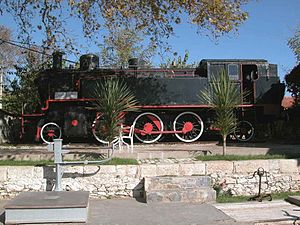CFO 331-340
| CFO 331-340 TCDD 35.51-60 |
|
|---|---|
|
35.58 Çamlık Railway Museum (2002)
|
|
| Numbering: |
CFO 331-340 TCDD 35.51-35.60 |
| Number: | 10 |
| Manufacturer: | Maffei |
| Year of construction (s): | 1911/12 |
| Retirement: | until 1982 |
| Axis formula : | 1'C1 ' |
| Type : | 1'C1 'n2t |
| Gauge : | 1435 mm ( standard gauge ) |
| Length over buffers: | 13030 mm |
| Fixed wheelbase: | 3700 mm |
| Total wheelbase: | 8900 mm |
| Service mass: | 71.4 t , after conversion 77.5 t |
| Friction mass: | 45.0 t, after conversion 49.2 t |
| Wheel set mass : | 15.0 t, after conversion 16.4 t |
| Top speed: | 70 km / h |
| Starting tractive effort: | 10050 N |
| Coupling wheel diameter: | 1410 mm |
| Driving wheel diameter: | 1410 mm |
| Impeller diameter front: | 1010 mm |
| Rear wheel diameter: | 1010 mm |
| Number of cylinders: | 2 |
| Cylinder diameter: | 500 mm |
| Piston stroke: | 630 mm |
| Boiler overpressure: | 12 bar |
| Grate area: | 2.75 m² |
| Radiant heating surface: | 12.0 m² |
| Evaporation heating surface: | 165.7 m² |
| Water supply: | 7.0 m 3 , after renovation 11.0 m 3 |
| Fuel supply: | 2.75 t, after modification 3.5 t |
| Coupling type: | Screw coupling |
The tank locomotives 331–340 of Chemins de fer Orientaux (CFO) were delivered in 1911 and 1912 by the Maffei locomotive factory in Munich for use in suburban traffic from Istanbul . Together with the CFO, the locomotives went to the Turkish state railway TCDD in 1937, which decommissioned the last machines in the early 1980s.
history
In the years before the First World War , the CFO used older, small tank locomotives with a 1'B wheel arrangement supplied by Krauss in 1875 for its suburban traffic from Istanbul Sirkeci station . These were soon no longer able to cope with the increasing tensile loads. The CFO therefore ordered a series of ten large tank locomotives with a 1'C1 '( Prairie ) wheel arrangement from Maffei . After their delivery under the Maffei serial numbers 3278 to 3283 and 3342 to 3345, they took over all suburban traffic on the route from Istanbul to the suburb of Halkali. This route remained the main area of operation for over forty years, which was not changed by the nationalization of the CFO in 1937. The locomotives hauled up to 20 two-axle trains in this forerunner of today 's Istanbul S-Bahn, known as Banliyö Trenleri . In 1955, their route was electrified by the TCDD. The locomotives were relocated to Izmir , where they were used in local traffic. From the beginning of the 1970s they gradually migrated to the shunting service and were used in large train stations across the country, individual copies came to Afyonkarahisar and Kayseri , among others . The last machine to be used was the 35.56, which provided shunting services in the port of Samsun in 1981 . It was installed as a memorial locomotive at Amasya station after 1986 . The locomotive 35.58 remained in the Çamlık Railway Museum as a museum locomotive.
technical features
The locomotives were designed as two-cylinder wet steam locomotives . Contrary to some information in the literature, they were not retrofitted with superheaters . The sheet metal frame received an internal water container between the frame cheeks, two further small water containers were on the side of the boiler. These soon turned out to be too small and all locomotives received significantly larger lateral water tanks when they were converted. With this conversion, the total weight of the locomotives increased by a good six tons to a total of 77.5 tons. The running wheels are stored in Bissel racks.
literature
- Benno Bickel, Karl-Wilhelm Koch, Florian Schmidt: Steam under the half moon. The last few years of steam operation in Turkey. Verlag Röhr, Krefeld 1987, ISBN 3-88490-183-4
- AE Durrant: The Steam Locomotives of Eastern Europe. David & Charles, Newton Abbot 1972, ISBN 0-7153-4077-8
- Wolfgang Lübsen: The Orientbahn and its locomotives . in: Lok-Magazin 57, December 1972, pp. 448–452
Web links
- Trains of Turkey: 3551 to 3560 (English)
Individual evidence
- ↑ Trains of Turkey: Preserved Steam , accessed November 1, 2015
